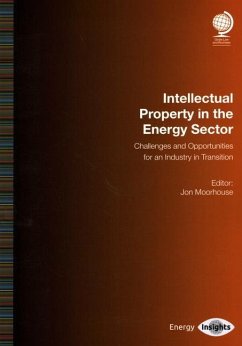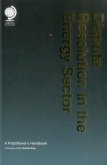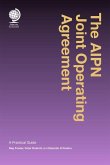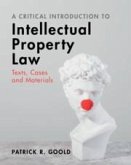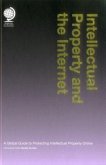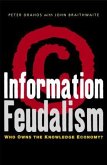Jon Moorhouse
Intellectual Property in the Energy Sector
Challenges and Opportunities for an Industry in Transition
Jon Moorhouse
Intellectual Property in the Energy Sector
Challenges and Opportunities for an Industry in Transition
- Broschiertes Buch
- Merkliste
- Auf die Merkliste
- Bewerten Bewerten
- Teilen
- Produkt teilen
- Produkterinnerung
- Produkterinnerung
This Special Report looks at the challenges and opportunities that intellectual property issues present for different areas of this broad and rapidly changing sector, including upstream, downstream, renewables, digitalisation, Standard Essential Patents and brand and reputation.
Andere Kunden interessierten sich auch für
![Dispute Resolution in the Energy Sector Dispute Resolution in the Energy Sector]() Ronnie KingDispute Resolution in the Energy Sector211,99 €
Ronnie KingDispute Resolution in the Energy Sector211,99 €![The Aipn Joint Operating Agreement The Aipn Joint Operating Agreement]() Reginald FowlerThe Aipn Joint Operating Agreement281,99 €
Reginald FowlerThe Aipn Joint Operating Agreement281,99 €![A Critical Introduction to Intellectual Property Law A Critical Introduction to Intellectual Property Law]() Patrick R. Goold (City University of London)A Critical Introduction to Intellectual Property Law50,99 €
Patrick R. Goold (City University of London)A Critical Introduction to Intellectual Property Law50,99 €![Intellectual Property and the Internet Intellectual Property and the Internet]() Intellectual Property and the Internet198,99 €
Intellectual Property and the Internet198,99 €![Information Feudalism Information Feudalism]() Peter DrahosInformation Feudalism58,99 €
Peter DrahosInformation Feudalism58,99 €![Indigenous Intellectual Property Indigenous Intellectual Property]() Dr. Val NapoleonIndigenous Intellectual Property33,99 €
Dr. Val NapoleonIndigenous Intellectual Property33,99 €![International Arbitration of Renewable Energy Disputes International Arbitration of Renewable Energy Disputes]() Emma JohnsonInternational Arbitration of Renewable Energy Disputes171,99 €
Emma JohnsonInternational Arbitration of Renewable Energy Disputes171,99 €-
-
-
This Special Report looks at the challenges and opportunities that intellectual property issues present for different areas of this broad and rapidly changing sector, including upstream, downstream, renewables, digitalisation, Standard Essential Patents and brand and reputation.
Produktdetails
- Produktdetails
- Verlag: Globe Law and Business Ltd
- Seitenzahl: 112
- Erscheinungstermin: 30. Juli 2022
- Englisch
- Abmessung: 297mm x 212mm x 10mm
- Gewicht: 378g
- ISBN-13: 9781787428102
- ISBN-10: 1787428109
- Artikelnr.: 62597222
- Herstellerkennzeichnung
- Libri GmbH
- Europaallee 1
- 36244 Bad Hersfeld
- gpsr@libri.de
- Verlag: Globe Law and Business Ltd
- Seitenzahl: 112
- Erscheinungstermin: 30. Juli 2022
- Englisch
- Abmessung: 297mm x 212mm x 10mm
- Gewicht: 378g
- ISBN-13: 9781787428102
- ISBN-10: 1787428109
- Artikelnr.: 62597222
- Herstellerkennzeichnung
- Libri GmbH
- Europaallee 1
- 36244 Bad Hersfeld
- gpsr@libri.de
By Jon Moorhouse
Introduction 7
Jon Moorhouse
Keystone Law
I. Energy joint ventures: upstream 11
Jon Moorhouse
Keystone Law
1. Exploration 12
1.1 Data acquisition 12
1.2 Data processing and interpretation 14
2. Production 16
3. End of field life 22
4. Intellectual property management 22
II. A downstream perspective 25
Maeve O'Flynn
Finnegan Europe LLP
Paul Townsend
Finnegan LLP
1. Process technology 25
1.1 How can process technology be protected? 26
1.2 What protection is offered by process patents? 26
1.3 In which circumstances will competitor activity be outside the scope of
protection of your process patent? 27
1.4 How do you ensure that the claims of your process patent provide
commercially useful protection? 30
1.5 Will you be able to prove infringement of your process patent? 32
1.6 What is the value of your process patents? 32
2. Differentiated products 35
2.1 How should I protect products resulting from collaborative development?
35
2.2 How do I protect innovative products resulting from open innovation? 36
2.3 What are the IP challenges when considering freedom to operate for a
large portfolio of differentiated products? 38
3. Conclusion 40
III. Renewables: solar – spotlight on BNRG 43
Eoin Langford
BNRG Renewables Ltd
Jon Moorhouse
Keystone Law
1. Introduction 43
2. Hardware 44
2.1 The technology 44
2.2 Manufacture 47
2.3 Procurement 48
3. Project development and asset management 49
3.1 Site selection and design optimisation 49
3.2 EPC and partnering 51
4. Reputation and brand management 52
IV. Digitalisation 55
Charles T Collins-Chase
Kathryn R Judson
Paul Townsend
Finnegan LLP
1. Digitalisation and artificial intelligence are rapidly changing the
energy industry 55
2. Potential intellectual property issues facing AI and digital innovations
57
2.1 Patent eligibility 57
2.2 Patent inventorship 59
2.3 Trade secret protection 60
3. Patents: common issues and strategies 62
3.1 Strategies for overcoming patent-eligibility challenges 62
3.2 Strategies for avoiding inventorship issues 66
4. Trade secrets: strategies for navigating common pitfalls 67
5. Conclusion 71
V. Standard essential patents: licensing challenges for energy companies 75
Robert Pocknell
Keystone Law
1. Standards in the energy industry 76
1.1 Smart meters 76
1.2 Autonomous driving 77
1.3 Electric vehicle charging 77
2. What is the standards-setting process? 77
3. What SEP issues arise in the standards-setting process? 79
4. What does FRAND (fair, reasonable and non-discriminatory) mean? 80
5. Why are these telecoms issues relevant to the energy industry? 83
5.1 Example: a ‘smart' water flow meter 84
6. What can be done? 86
VI. Brand protection 89
Sean Ibbetson
Bristows LLP
1. Introduction: the value of brands in the energy sector 89
2. How the energy sector protects its brands 90
2.1 Trademarks (registered) 90
2.2 Trademarks (unregistered) 97
2.3 Designs (registered and unregistered) 99
2.4 Copyright 100
3. Enforcement issues: jurisdiction, remedies and online enforcement 101
3.1 Jurisdiction 101
3.2 Remedies 101
3.3 Online enforcement issues 103
4. Advertising disputes 106
5. Conclusion 106
About the authors 108
About Globe Law and Business 112
Jon Moorhouse
Keystone Law
I. Energy joint ventures: upstream 11
Jon Moorhouse
Keystone Law
1. Exploration 12
1.1 Data acquisition 12
1.2 Data processing and interpretation 14
2. Production 16
3. End of field life 22
4. Intellectual property management 22
II. A downstream perspective 25
Maeve O'Flynn
Finnegan Europe LLP
Paul Townsend
Finnegan LLP
1. Process technology 25
1.1 How can process technology be protected? 26
1.2 What protection is offered by process patents? 26
1.3 In which circumstances will competitor activity be outside the scope of
protection of your process patent? 27
1.4 How do you ensure that the claims of your process patent provide
commercially useful protection? 30
1.5 Will you be able to prove infringement of your process patent? 32
1.6 What is the value of your process patents? 32
2. Differentiated products 35
2.1 How should I protect products resulting from collaborative development?
35
2.2 How do I protect innovative products resulting from open innovation? 36
2.3 What are the IP challenges when considering freedom to operate for a
large portfolio of differentiated products? 38
3. Conclusion 40
III. Renewables: solar – spotlight on BNRG 43
Eoin Langford
BNRG Renewables Ltd
Jon Moorhouse
Keystone Law
1. Introduction 43
2. Hardware 44
2.1 The technology 44
2.2 Manufacture 47
2.3 Procurement 48
3. Project development and asset management 49
3.1 Site selection and design optimisation 49
3.2 EPC and partnering 51
4. Reputation and brand management 52
IV. Digitalisation 55
Charles T Collins-Chase
Kathryn R Judson
Paul Townsend
Finnegan LLP
1. Digitalisation and artificial intelligence are rapidly changing the
energy industry 55
2. Potential intellectual property issues facing AI and digital innovations
57
2.1 Patent eligibility 57
2.2 Patent inventorship 59
2.3 Trade secret protection 60
3. Patents: common issues and strategies 62
3.1 Strategies for overcoming patent-eligibility challenges 62
3.2 Strategies for avoiding inventorship issues 66
4. Trade secrets: strategies for navigating common pitfalls 67
5. Conclusion 71
V. Standard essential patents: licensing challenges for energy companies 75
Robert Pocknell
Keystone Law
1. Standards in the energy industry 76
1.1 Smart meters 76
1.2 Autonomous driving 77
1.3 Electric vehicle charging 77
2. What is the standards-setting process? 77
3. What SEP issues arise in the standards-setting process? 79
4. What does FRAND (fair, reasonable and non-discriminatory) mean? 80
5. Why are these telecoms issues relevant to the energy industry? 83
5.1 Example: a ‘smart' water flow meter 84
6. What can be done? 86
VI. Brand protection 89
Sean Ibbetson
Bristows LLP
1. Introduction: the value of brands in the energy sector 89
2. How the energy sector protects its brands 90
2.1 Trademarks (registered) 90
2.2 Trademarks (unregistered) 97
2.3 Designs (registered and unregistered) 99
2.4 Copyright 100
3. Enforcement issues: jurisdiction, remedies and online enforcement 101
3.1 Jurisdiction 101
3.2 Remedies 101
3.3 Online enforcement issues 103
4. Advertising disputes 106
5. Conclusion 106
About the authors 108
About Globe Law and Business 112
Introduction 7
Jon Moorhouse
Keystone Law
I. Energy joint ventures: upstream 11
Jon Moorhouse
Keystone Law
1. Exploration 12
1.1 Data acquisition 12
1.2 Data processing and interpretation 14
2. Production 16
3. End of field life 22
4. Intellectual property management 22
II. A downstream perspective 25
Maeve O'Flynn
Finnegan Europe LLP
Paul Townsend
Finnegan LLP
1. Process technology 25
1.1 How can process technology be protected? 26
1.2 What protection is offered by process patents? 26
1.3 In which circumstances will competitor activity be outside the scope of
protection of your process patent? 27
1.4 How do you ensure that the claims of your process patent provide
commercially useful protection? 30
1.5 Will you be able to prove infringement of your process patent? 32
1.6 What is the value of your process patents? 32
2. Differentiated products 35
2.1 How should I protect products resulting from collaborative development?
35
2.2 How do I protect innovative products resulting from open innovation? 36
2.3 What are the IP challenges when considering freedom to operate for a
large portfolio of differentiated products? 38
3. Conclusion 40
III. Renewables: solar – spotlight on BNRG 43
Eoin Langford
BNRG Renewables Ltd
Jon Moorhouse
Keystone Law
1. Introduction 43
2. Hardware 44
2.1 The technology 44
2.2 Manufacture 47
2.3 Procurement 48
3. Project development and asset management 49
3.1 Site selection and design optimisation 49
3.2 EPC and partnering 51
4. Reputation and brand management 52
IV. Digitalisation 55
Charles T Collins-Chase
Kathryn R Judson
Paul Townsend
Finnegan LLP
1. Digitalisation and artificial intelligence are rapidly changing the
energy industry 55
2. Potential intellectual property issues facing AI and digital innovations
57
2.1 Patent eligibility 57
2.2 Patent inventorship 59
2.3 Trade secret protection 60
3. Patents: common issues and strategies 62
3.1 Strategies for overcoming patent-eligibility challenges 62
3.2 Strategies for avoiding inventorship issues 66
4. Trade secrets: strategies for navigating common pitfalls 67
5. Conclusion 71
V. Standard essential patents: licensing challenges for energy companies 75
Robert Pocknell
Keystone Law
1. Standards in the energy industry 76
1.1 Smart meters 76
1.2 Autonomous driving 77
1.3 Electric vehicle charging 77
2. What is the standards-setting process? 77
3. What SEP issues arise in the standards-setting process? 79
4. What does FRAND (fair, reasonable and non-discriminatory) mean? 80
5. Why are these telecoms issues relevant to the energy industry? 83
5.1 Example: a ‘smart' water flow meter 84
6. What can be done? 86
VI. Brand protection 89
Sean Ibbetson
Bristows LLP
1. Introduction: the value of brands in the energy sector 89
2. How the energy sector protects its brands 90
2.1 Trademarks (registered) 90
2.2 Trademarks (unregistered) 97
2.3 Designs (registered and unregistered) 99
2.4 Copyright 100
3. Enforcement issues: jurisdiction, remedies and online enforcement 101
3.1 Jurisdiction 101
3.2 Remedies 101
3.3 Online enforcement issues 103
4. Advertising disputes 106
5. Conclusion 106
About the authors 108
About Globe Law and Business 112
Jon Moorhouse
Keystone Law
I. Energy joint ventures: upstream 11
Jon Moorhouse
Keystone Law
1. Exploration 12
1.1 Data acquisition 12
1.2 Data processing and interpretation 14
2. Production 16
3. End of field life 22
4. Intellectual property management 22
II. A downstream perspective 25
Maeve O'Flynn
Finnegan Europe LLP
Paul Townsend
Finnegan LLP
1. Process technology 25
1.1 How can process technology be protected? 26
1.2 What protection is offered by process patents? 26
1.3 In which circumstances will competitor activity be outside the scope of
protection of your process patent? 27
1.4 How do you ensure that the claims of your process patent provide
commercially useful protection? 30
1.5 Will you be able to prove infringement of your process patent? 32
1.6 What is the value of your process patents? 32
2. Differentiated products 35
2.1 How should I protect products resulting from collaborative development?
35
2.2 How do I protect innovative products resulting from open innovation? 36
2.3 What are the IP challenges when considering freedom to operate for a
large portfolio of differentiated products? 38
3. Conclusion 40
III. Renewables: solar – spotlight on BNRG 43
Eoin Langford
BNRG Renewables Ltd
Jon Moorhouse
Keystone Law
1. Introduction 43
2. Hardware 44
2.1 The technology 44
2.2 Manufacture 47
2.3 Procurement 48
3. Project development and asset management 49
3.1 Site selection and design optimisation 49
3.2 EPC and partnering 51
4. Reputation and brand management 52
IV. Digitalisation 55
Charles T Collins-Chase
Kathryn R Judson
Paul Townsend
Finnegan LLP
1. Digitalisation and artificial intelligence are rapidly changing the
energy industry 55
2. Potential intellectual property issues facing AI and digital innovations
57
2.1 Patent eligibility 57
2.2 Patent inventorship 59
2.3 Trade secret protection 60
3. Patents: common issues and strategies 62
3.1 Strategies for overcoming patent-eligibility challenges 62
3.2 Strategies for avoiding inventorship issues 66
4. Trade secrets: strategies for navigating common pitfalls 67
5. Conclusion 71
V. Standard essential patents: licensing challenges for energy companies 75
Robert Pocknell
Keystone Law
1. Standards in the energy industry 76
1.1 Smart meters 76
1.2 Autonomous driving 77
1.3 Electric vehicle charging 77
2. What is the standards-setting process? 77
3. What SEP issues arise in the standards-setting process? 79
4. What does FRAND (fair, reasonable and non-discriminatory) mean? 80
5. Why are these telecoms issues relevant to the energy industry? 83
5.1 Example: a ‘smart' water flow meter 84
6. What can be done? 86
VI. Brand protection 89
Sean Ibbetson
Bristows LLP
1. Introduction: the value of brands in the energy sector 89
2. How the energy sector protects its brands 90
2.1 Trademarks (registered) 90
2.2 Trademarks (unregistered) 97
2.3 Designs (registered and unregistered) 99
2.4 Copyright 100
3. Enforcement issues: jurisdiction, remedies and online enforcement 101
3.1 Jurisdiction 101
3.2 Remedies 101
3.3 Online enforcement issues 103
4. Advertising disputes 106
5. Conclusion 106
About the authors 108
About Globe Law and Business 112

